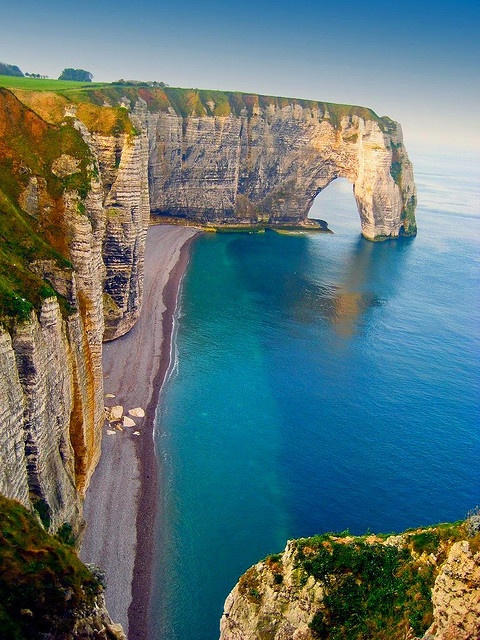Sea Cliffs, Etretat, France

Étretat is a commune in the Seine-Maritime department in the Haute-Normandie region in north-western France. It is a tourist and farming town situated about 32 km (20 mi) northeast of Le Havre, at the junction of the D 940, D 11 and D 139 roads. It's located on the coast of the Pays de Caux area.
Étretat is best known for its cliffs, including three natural arches and the pointed "needle". These cliffs and the associated resort beach attracted artists including Eugène Boudin, Gustave Courbet and Claude Monet, and were featured prominently in the 1909 Arsène Lupin novel The Hollow Needle by Maurice Leblanc.
Two of the three famous arches are seen from the town, the Porte d'Aval, and the Porte d'Amont. The Manneporte is the third and the biggest one, and cannot be seen from the town.
The GR 21 long-distance hiking path (Le Havre to Le Tréport) passes through the town.
Guy de Maupassant (1850–1893) spent most of his childhood in Étretat, at "Les Verguies". In 1882 he wrote a short story for Le Gaulois entitled "The Englishman of Étretat" (L'Anglais d'Étretat), based on encounters in 1868, as a house guest of G. E. J. Powell, with the English poet Algernon Charles Swinburne, whom he had helped save from drowning. The dried human hand displayed on one of the tables was later acquired by Maupassant to adorn his Paris apartment; it inspired another short story, "The Flayed Hand" (La Main Écorchée).[1] In 1883 he built his own house in Étretat, "La Guillette", in the Mediterranean style in "Le Grand Val", since renamed rue Guy-de-Maupassant.[2] Jean-Baptiste Faure (1830–1914), the great French operatic baritone whose career centred on Paris and London, also owned a villa there. A friend of the artist Édouard Manet and a keen collector of art, Faure did amateur paintings of the local area, including the scenic cliff.

Étretat is a commune in the Seine-Maritime department in the Haute-Normandie region in north-western France. It is a tourist and farming town situated about 32 km (20 mi) northeast of Le Havre, at the junction of the D 940, D 11 and D 139 roads. It's located on the coast of the Pays de Caux area.
Étretat is best known for its cliffs, including three natural arches and the pointed "needle". These cliffs and the associated resort beach attracted artists including Eugène Boudin, Gustave Courbet and Claude Monet, and were featured prominently in the 1909 Arsène Lupin novel The Hollow Needle by Maurice Leblanc.
Two of the three famous arches are seen from the town, the Porte d'Aval, and the Porte d'Amont. The Manneporte is the third and the biggest one, and cannot be seen from the town.
The GR 21 long-distance hiking path (Le Havre to Le Tréport) passes through the town.
Notable People
Étretat was the birthplace of Élie Halévy (1870–1937), philosopher and historian.Guy de Maupassant (1850–1893) spent most of his childhood in Étretat, at "Les Verguies". In 1882 he wrote a short story for Le Gaulois entitled "The Englishman of Étretat" (L'Anglais d'Étretat), based on encounters in 1868, as a house guest of G. E. J. Powell, with the English poet Algernon Charles Swinburne, whom he had helped save from drowning. The dried human hand displayed on one of the tables was later acquired by Maupassant to adorn his Paris apartment; it inspired another short story, "The Flayed Hand" (La Main Écorchée).[1] In 1883 he built his own house in Étretat, "La Guillette", in the Mediterranean style in "Le Grand Val", since renamed rue Guy-de-Maupassant.[2] Jean-Baptiste Faure (1830–1914), the great French operatic baritone whose career centred on Paris and London, also owned a villa there. A friend of the artist Édouard Manet and a keen collector of art, Faure did amateur paintings of the local area, including the scenic cliff.


No comments:
Post a Comment